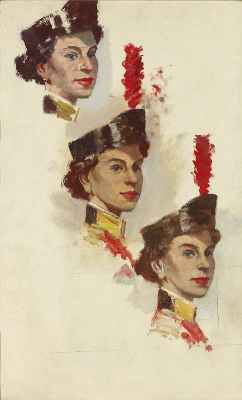
Three Portrait Studies of Her Majesty The Queen by Edward Seago. Photo (c) Estate of Edward Seago courtesy of Portland Gallery, London
Welcome Ode, Op.95, for young people’s chorus (SAB, with optional T) and orchestra (19 August 1976, approved by Britten on 8 October 1976, Britten aged 62)
Dedication Written for the occasion of Her Majesty the Queen’s Silver Jubilee visit to Ipswich on 11 July 1977
Text Various
Duration 7’30”
1 March (Thomas Dekker and John Ford)
2 Jig (orchestra)
3 Roundel (Anon, 1600)
4 Modulation (orchestra)
5 Canon (Henry Fielding)
Background and Critical Reception
Britten’s final completed composition returned him to writing for the people he loved most of all – children. Composed for the Queen’s Silver Jubilee in 1977, Welcome Ode – classed as a short cantata – is for young people’s choir and orchestra, written for performance on the occasion of the Queen’s visit to Ipswich on 11 July of Jubilee year. Colin Matthews, who was working as Britten’s assistant, completed the orchestration under careful supervision from the composer.
Initially Britten suggested a score for only ‘high register’, ‘middle register’ instruments etc – as in Psalm 150 – but decided against what he saw as ‘writing down’ to the players, and changed the scoring to include as many ad lib instruments as were available.
Though a short piece, Welcome Ode has five linked sections, with a march, jig and canon that John Bridcut describes as ‘familiar Britten terrain. But it is moving to find that, when his physical strength was failing for the final time, the bounce in the music was as exuberant as ever. It is…Britten at his most generous.’
Thoughts
After the haunting folksong settings completed earlier in 1976, it is something of a relief to witness Britten returning to music of greater exuberance and ceremony, in spite of his ailing body. Welcome Ode is cheery, celebratory music that bursts forth, just like opening the window on a windy day or bright, sunny morning.
It is a big orchestral sound that Britten chooses, with brass to the fore, and the harmonies are typically bold. It is interesting to note that the key the music ends in – B flat major – has served other ceremonial pieces well, such as the Canadian Carnival. The triumphant end carries a striking similarity to the end of Sibelius’ Symphony no.5 in its clever alternation of silence and massive, block chords.
Recordings used
Jubilee Choir, Suffolk Schools’ Orchestra / Keith Shaw (Decca)
Senior Choirs of the City of London School for Girls, City of London School, London Symphony Orchestra / Richard Hickox (Chandos)
Perhaps not surprisingly, owing to its forces, there are few available recordings of the Welcome Ode – the first of which is made by the original forces from the 1977 premiere. It proceeds with enjoyable bluster and occasion, the children sing enthusiastically and the brass of the school orchestra adds the pageantry.
Richard Hickox benefits from improved sound and a professional orchestra, adding tighter ensemble to the brassy passages – but at the same time losing a little of the original’s amateur appeal.
Spotify
The Hickox version can be heard here, on a Chandos release that includes the Spring Symphony and Psalm 150.
Also written in 1976: Philip Glass – Einstein on the Beach
Next up: Praise We Great Men
